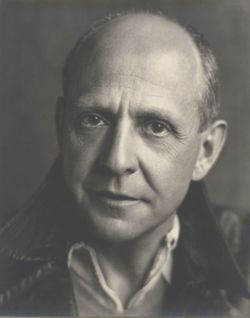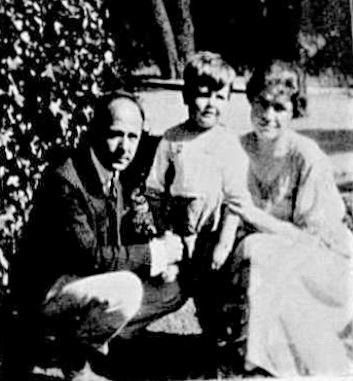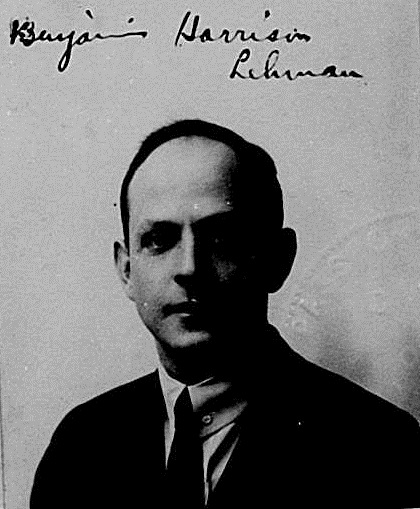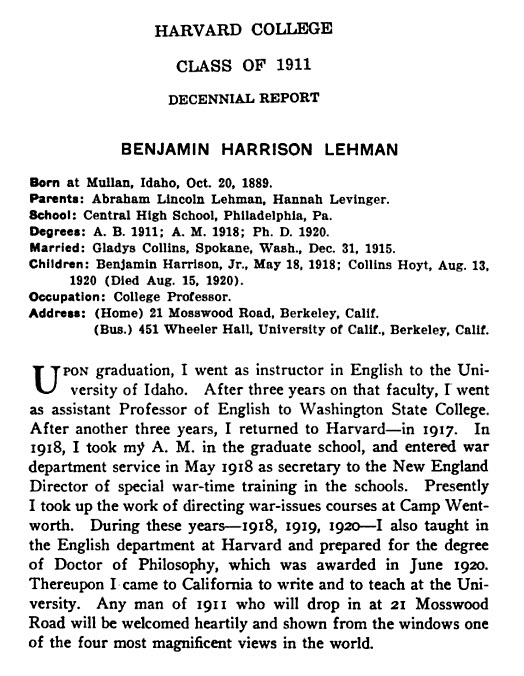Cremated
Step-Father-In-Law of Gary Jerome Torre
********************
Brother of:
Walter Joseph Lehman
********************
First wife was Gladys M Collins
Birth 24 Jan 1892 in Gates, Linn, OR
Death 7 Apr 1993 in Newport Beach, Orange, CA
They had two children:
Collins Hoyt August 13, 1920 - August 15, 1920
Benjamin Harrison 'Hal' Lehman Jr
Birth 18 May 1918 in Boston, Suffolk, MA
Death 26 Feb 2013 in Newport Beach, Orange, CA
By 1930, Gladys is listed as living in San Fernando, Los Angeles, CA. Divorced, motion picture writer; owns home 10173 Toluca Lake Avenue, valued @ $7,000; lives with son Hal & servant.
********************
1910 Census:
Dr. Abraham Lincoln Lehman (Allopath doctor) (14 Apr 1865 in NY - 19 Oct 1917 ID) Mother's maiden: Bernheim. Father's name: David Lehman
Hannah Levingen Lehman (Born in Germany)
Benjamin Harrison Lehman (Born abt 1890 in ID)
Walter Joseph Lehman
Fannie Lehman Vaughan (Born abt 1892 in ID). Has daughter Margaret Vaughan b. abt 1920 in PA
Harry David Lehman (30 Jun 1895 in PA - Feb 1987) University of PA, BS in Chem Engineering
Rachel H Lehman (Born abt 1900 in PA)
********************
Benjamin Harrison Lehman, English; Dramatic Art: Berkeley
1889-1977
Professor of English, Emeritus
A strong European intellectual heritage, a mining-town boyhood, a Harvard literary education, and pioneering teaching in Idaho and Washington, brought B.H. Lehman to Berkeley in 1920 with his wife Gladys and son Hal, to a role of teaching and writing that developed into a role of major University leadership. Above all, Lehman was the appreciator, the student of Royce, Perry, Santayana, the admirer of Carlyle's hero-worship in its nineteenth-century contexts, the valuer of fine paintings, fine gardens, and fine conversation. Still in this receptive spirit, he became in the 1930s and 1940s forcefully active in such appreciation, looking for better ways in committee and department work to advance a good University library, a good drama production, a good young professor who needed what he has called a “window on the sea.”
Although he denied possessing any irresistible primary interest in the theatre, saying that people always assumed the stage was in his blood because he had married successively a scenarist, an actress, and a dramatic poet, Benjamin Lehman was perhaps understating his dedication to what theatre could be. As a young man, he had followed Duse around Europe, and among his memorable lectures was a description of her performance in A Lady from the Sea, an account that was vivid with the remembered presence of the actress. In the same way, he described the performance of Judith Anderson in the final moments of Strange Interlude, when she seemed to age into infinity, beyond the time-span of the play. Always, when he spoke of theatrical performance, he was responsive to the dramatic moment, and his descriptions caused admiration not only for performer but for playwright, indeed for the essence of theatre at its best.
He lived in London in 1938-39 and found easy companionship among the theatre's brightest denizens--Olivier, Gielgud, Vivian Leigh, Judith Anderson. The experience he partly mocked for its excess of “glamor,” but he also noted that the experience of these associations proved of importance when he was asked to form a department of dramatic art on the Berkeley campus. His associations with professionals were kept alive and reinforced by ritual yearly trips to New York City to see the newest theatre. Similarly, his work as novelist, critic, and popular lecturer brought him into association with James Phelan, Noel Sullivan, Albert Bender, Robinson Jeffers, and other leaders in artistic circles.
Between 1941 and 1944, Lehman served as the first chairman of the newly established Department of Dramatic Art at Berkeley. With his characteristically strong sense of historical continuity, Lehman remembered the time when the Berkeley campus, chiefly by means of productions at the Hearst Greek Theatre, became known as a place where important dramatic productions of high artistic quality had been regularly staged. He joined willingly with his colleagues Stephen Pepper and Willard Durham to define the nature and structure of a theatre department that would be a worthy successor to past achievement and appropriate to a university's aims. It has served as a model for similar departments on other campuses.
During his years as chairman of the Budget Committee, 1944-1946, Lehman initiated the development of a comprehensive personnel file for the committee. Prior to his chairmanship, the Budget Committee had kept few copies of the reports and recommendations it had received, and even lacked a complete file of its reports to the President. Lehman changed all that, to the lasting benefit of faculty participation in academic personnel matters. Under his chairmanship, the Budget Committee made another important contribution to faculty welfare: it strongly recommended a greatly increased academic salary scale--the first salary scale increase in many years. From 1944-45 to 1948-49, Lehman was chairman of the Department of English, and colleagues noted how well he carried out an important function of a department chairman--that of recommending appointments, salary increases, promotions, and terminations. As a member of the University Welfare committee in 1951-52, he helped obtain a vast improvement in the University's retirement system--an improvement that many here are now enjoying. At one time or another throughout his long career in the University, he served on almost every important academic and administrative committee. In terms of both quantity and quality of service on these committees, he had few equals and no superiors.
Above other renowned teachers like Kittredge and Babbitt a colleague places Lehman, because of what he calls his steely strenuousness, his demand on students and colleagues subtly made--mysterious as to what he had in mind, and puzzling, yet ultimately, after the twelfth rewriting or rethinking, to be seen as the student's own potential. Some remember him as intellectually cold; others, as highly moved and moving, by and for the works of art he dealt with, by and for his students and the University.
A former student writes,
I see Ben Lehman as clearly as I saw him the first day in sophomore writing class; an arrogant walk to the lectern, careful tailoring, wide-gesturing hands with a huge ring on one of them; and then, the excitement of that voice of his, such a manipulative persuasive voice, coaxing, exhorting, commanding us to think, to read, to write. Spoken in strange bright language it was an outrageously theatrical performance. With no idea how sharp, how demanding he could be, we had yet to discover the deep wells of patience he would gladly pump dry for us.
His graduate students' essays in the festschrift of 1955, The Image of the Work, exemplified the main purpose of all his teaching, to render a vision of the work in its entirety, its totality; and his sense of people was like his sense of literature--visionary. “We didn't choose young scholars and teachers for distinction,” he said in his oral history. “We chose them for promise and then helped them achieve the distinction. We followed precepts like Booker T. Washington's 'Do the thing that is next,' and Carlyle's 'the duty that is nearest thee?”' He admired and helped to create not only works of art but students, colleagues, celebrities, even academic processes significant as entities worth man's best imagination.
Josephine Miles
Travis Bogard
Harry Wellman
SOURCE
********************
First wife:
Gladys M Collins
Birth 24 Jan 1892 in Gates, Linn, OR
Death 7 Apr 1993 in Newport Beach, Orange, CA
They married Dec 1915 in Spokane, WA.
They divorced around 1928 in CA.
She was a staff scenarist writer for Fox Film Corporation in Los Angeles.
********************
Second wife:
Dame Judith Anderson
10 February 1897 – 3 January 1992
She was an Australian actress who had a successful career in stage, film and television. She won two Emmy Awards and a Tony Award and was also nominated for a Grammy Award and an Academy Award.
She married Benjamin Harrison Lehmann (1889–1977), an English professor at the University of California at Berkeley; they wed secretly in 1937 in Kingman, AZ (Honeymooned at the Grand Canyon) and divorced in August 1939. By this marriage she had a stepson, Benjamin Harrison Lehmann, Jr. (born 1918).
********************
Third wife:
Henriette de Saussure Blanding Lehman (1891 - 1973)
Married in 1957
********************
Cremated
Step-Father-In-Law of Gary Jerome Torre
********************
Brother of:
Walter Joseph Lehman
********************
First wife was Gladys M Collins
Birth 24 Jan 1892 in Gates, Linn, OR
Death 7 Apr 1993 in Newport Beach, Orange, CA
They had two children:
Collins Hoyt August 13, 1920 - August 15, 1920
Benjamin Harrison 'Hal' Lehman Jr
Birth 18 May 1918 in Boston, Suffolk, MA
Death 26 Feb 2013 in Newport Beach, Orange, CA
By 1930, Gladys is listed as living in San Fernando, Los Angeles, CA. Divorced, motion picture writer; owns home 10173 Toluca Lake Avenue, valued @ $7,000; lives with son Hal & servant.
********************
1910 Census:
Dr. Abraham Lincoln Lehman (Allopath doctor) (14 Apr 1865 in NY - 19 Oct 1917 ID) Mother's maiden: Bernheim. Father's name: David Lehman
Hannah Levingen Lehman (Born in Germany)
Benjamin Harrison Lehman (Born abt 1890 in ID)
Walter Joseph Lehman
Fannie Lehman Vaughan (Born abt 1892 in ID). Has daughter Margaret Vaughan b. abt 1920 in PA
Harry David Lehman (30 Jun 1895 in PA - Feb 1987) University of PA, BS in Chem Engineering
Rachel H Lehman (Born abt 1900 in PA)
********************
Benjamin Harrison Lehman, English; Dramatic Art: Berkeley
1889-1977
Professor of English, Emeritus
A strong European intellectual heritage, a mining-town boyhood, a Harvard literary education, and pioneering teaching in Idaho and Washington, brought B.H. Lehman to Berkeley in 1920 with his wife Gladys and son Hal, to a role of teaching and writing that developed into a role of major University leadership. Above all, Lehman was the appreciator, the student of Royce, Perry, Santayana, the admirer of Carlyle's hero-worship in its nineteenth-century contexts, the valuer of fine paintings, fine gardens, and fine conversation. Still in this receptive spirit, he became in the 1930s and 1940s forcefully active in such appreciation, looking for better ways in committee and department work to advance a good University library, a good drama production, a good young professor who needed what he has called a “window on the sea.”
Although he denied possessing any irresistible primary interest in the theatre, saying that people always assumed the stage was in his blood because he had married successively a scenarist, an actress, and a dramatic poet, Benjamin Lehman was perhaps understating his dedication to what theatre could be. As a young man, he had followed Duse around Europe, and among his memorable lectures was a description of her performance in A Lady from the Sea, an account that was vivid with the remembered presence of the actress. In the same way, he described the performance of Judith Anderson in the final moments of Strange Interlude, when she seemed to age into infinity, beyond the time-span of the play. Always, when he spoke of theatrical performance, he was responsive to the dramatic moment, and his descriptions caused admiration not only for performer but for playwright, indeed for the essence of theatre at its best.
He lived in London in 1938-39 and found easy companionship among the theatre's brightest denizens--Olivier, Gielgud, Vivian Leigh, Judith Anderson. The experience he partly mocked for its excess of “glamor,” but he also noted that the experience of these associations proved of importance when he was asked to form a department of dramatic art on the Berkeley campus. His associations with professionals were kept alive and reinforced by ritual yearly trips to New York City to see the newest theatre. Similarly, his work as novelist, critic, and popular lecturer brought him into association with James Phelan, Noel Sullivan, Albert Bender, Robinson Jeffers, and other leaders in artistic circles.
Between 1941 and 1944, Lehman served as the first chairman of the newly established Department of Dramatic Art at Berkeley. With his characteristically strong sense of historical continuity, Lehman remembered the time when the Berkeley campus, chiefly by means of productions at the Hearst Greek Theatre, became known as a place where important dramatic productions of high artistic quality had been regularly staged. He joined willingly with his colleagues Stephen Pepper and Willard Durham to define the nature and structure of a theatre department that would be a worthy successor to past achievement and appropriate to a university's aims. It has served as a model for similar departments on other campuses.
During his years as chairman of the Budget Committee, 1944-1946, Lehman initiated the development of a comprehensive personnel file for the committee. Prior to his chairmanship, the Budget Committee had kept few copies of the reports and recommendations it had received, and even lacked a complete file of its reports to the President. Lehman changed all that, to the lasting benefit of faculty participation in academic personnel matters. Under his chairmanship, the Budget Committee made another important contribution to faculty welfare: it strongly recommended a greatly increased academic salary scale--the first salary scale increase in many years. From 1944-45 to 1948-49, Lehman was chairman of the Department of English, and colleagues noted how well he carried out an important function of a department chairman--that of recommending appointments, salary increases, promotions, and terminations. As a member of the University Welfare committee in 1951-52, he helped obtain a vast improvement in the University's retirement system--an improvement that many here are now enjoying. At one time or another throughout his long career in the University, he served on almost every important academic and administrative committee. In terms of both quantity and quality of service on these committees, he had few equals and no superiors.
Above other renowned teachers like Kittredge and Babbitt a colleague places Lehman, because of what he calls his steely strenuousness, his demand on students and colleagues subtly made--mysterious as to what he had in mind, and puzzling, yet ultimately, after the twelfth rewriting or rethinking, to be seen as the student's own potential. Some remember him as intellectually cold; others, as highly moved and moving, by and for the works of art he dealt with, by and for his students and the University.
A former student writes,
I see Ben Lehman as clearly as I saw him the first day in sophomore writing class; an arrogant walk to the lectern, careful tailoring, wide-gesturing hands with a huge ring on one of them; and then, the excitement of that voice of his, such a manipulative persuasive voice, coaxing, exhorting, commanding us to think, to read, to write. Spoken in strange bright language it was an outrageously theatrical performance. With no idea how sharp, how demanding he could be, we had yet to discover the deep wells of patience he would gladly pump dry for us.
His graduate students' essays in the festschrift of 1955, The Image of the Work, exemplified the main purpose of all his teaching, to render a vision of the work in its entirety, its totality; and his sense of people was like his sense of literature--visionary. “We didn't choose young scholars and teachers for distinction,” he said in his oral history. “We chose them for promise and then helped them achieve the distinction. We followed precepts like Booker T. Washington's 'Do the thing that is next,' and Carlyle's 'the duty that is nearest thee?”' He admired and helped to create not only works of art but students, colleagues, celebrities, even academic processes significant as entities worth man's best imagination.
Josephine Miles
Travis Bogard
Harry Wellman
SOURCE
********************
First wife:
Gladys M Collins
Birth 24 Jan 1892 in Gates, Linn, OR
Death 7 Apr 1993 in Newport Beach, Orange, CA
They married Dec 1915 in Spokane, WA.
They divorced around 1928 in CA.
She was a staff scenarist writer for Fox Film Corporation in Los Angeles.
********************
Second wife:
Dame Judith Anderson
10 February 1897 – 3 January 1992
She was an Australian actress who had a successful career in stage, film and television. She won two Emmy Awards and a Tony Award and was also nominated for a Grammy Award and an Academy Award.
She married Benjamin Harrison Lehmann (1889–1977), an English professor at the University of California at Berkeley; they wed secretly in 1937 in Kingman, AZ (Honeymooned at the Grand Canyon) and divorced in August 1939. By this marriage she had a stepson, Benjamin Harrison Lehmann, Jr. (born 1918).
********************
Third wife:
Henriette de Saussure Blanding Lehman (1891 - 1973)
Married in 1957
********************
Family Members
Sponsored by Ancestry
Advertisement
Explore more
Sponsored by Ancestry
Advertisement













